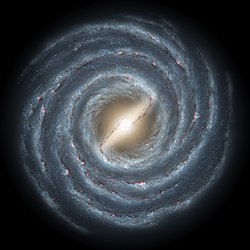Sagittarius-II-Zwerggalaxie
| Galaxie Sagittarius-II-Zwerggalaxie | |
|---|---|
| Sagittarius 2 | |
| AladinLite | |
| Sternbild | Schütze |
| Position Äquinoktium: J2000.0, Epoche: J2000.0 | |
| Rektaszension | 19h 52m 40,5s |
| Deklination | −22° 04′ 05″ |
| Erscheinungsbild | |
| Morphologischer Typ | dSph |
| Helligkeit (visuell) | (13,9 ± 0,4) mag |
| Physikalische Daten | |
| Zugehörigkeit | Lokale Gruppe |
| Entfernung | (195.600 ± 16.300) Lj / (60.000 ± 5.000) pc |
| Absolute Helligkeit | (−5,2 ± 0,4) mag |
| Metallizität [Fe/H] | −2,2 |
| Geschichte | |
| Entdeckung | Pan-STARRS Durchmusterung 1 |
| Entdeckungsdatum | 2015 |
| Katalogbezeichnungen | |
| Sag II dSph | |
Die Sagittarius-II-Zwerggalaxie, kurz auch Sagittarius II oder Sagittarius 2, ist eine im Jahr 2015 entdeckte Zwerggalaxie des Typs dSph im Sternbild Schütze in der Lokalen Gruppe und eine der Satellitengalaxien der Milchstraße.[1]
Eigenschaften
Sag II dSph besitzt einen Halblichtradius von ′, was bei einer Entfernung von etwa 60 kpc einer Größe von pc entspricht.
Weiteres
- Liste der Galaxien der Lokalen Gruppe
Einzelnachweise
- ↑ Benjamin P. M. Laevens et al.: Sagittarius II, Draco II and Laevens 3: Three New Milky Way Satellites Discovered in the PAN-STARRS 1 3π Survey. In: The Astrophysical Journal. 813, Nr. 1, 1. November 2015, S. 9. doi:10.1088/0004-637X/813/1/44.
Auf dieser Seite verwendete Medien
Caption from NASA: Like early explorers mapping the continents of our globe, astronomers are busy charting the spiral structure of our galaxy, the Milky Way. Using infrared images from NASA's Spitzer Space Telescope, scientists have discovered that the Milky Way's elegant spiral structure is dominated by just two arms wrapping off the ends of a central bar of stars. Previously, our galaxy was thought to possess four major arms.
This artist's concept illustrates the new view of the Milky Way, along with other findings presented at the 212th American Astronomical Society meeting in St. Louis, Mo. The galaxy's two major arms (Scutum-Centaurus and Perseus) can be seen attached to the ends of a thick central bar, while the two now-demoted minor arms (Norma and Sagittarius) are less distinct and located between the major arms. The major arms consist of the highest densities of both young and old stars; the minor arms are primarily filled with gas and pockets of star-forming activity.
The artist's concept also includes a new spiral arm, called the "Far-3 kiloparsec arm," discovered via a radio-telescope survey of gas in the Milky Way. This arm is shorter than the two major arms and lies along the bar of the galaxy.
Our sun lies near a small, partial arm called the Orion Arm, or Orion Spur, located between the Sagittarius and Perseus arms.



